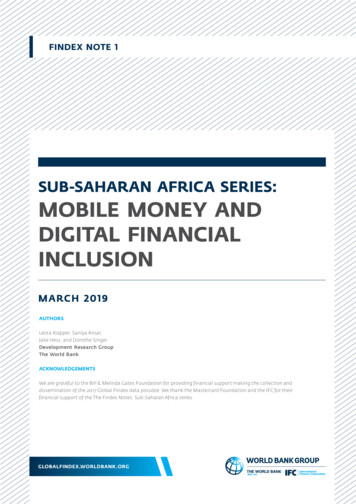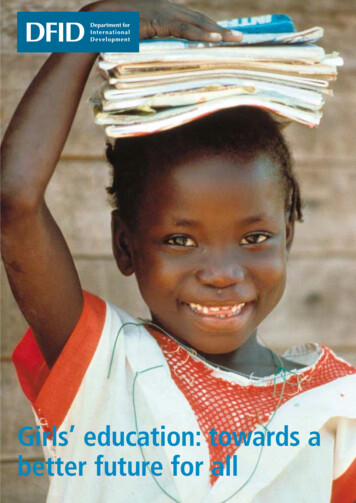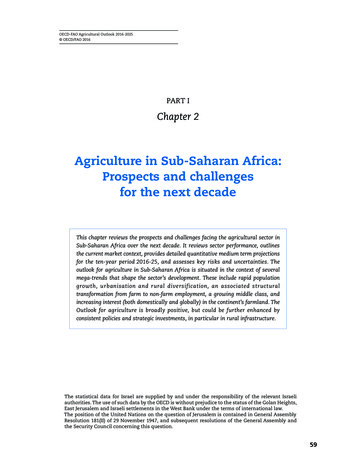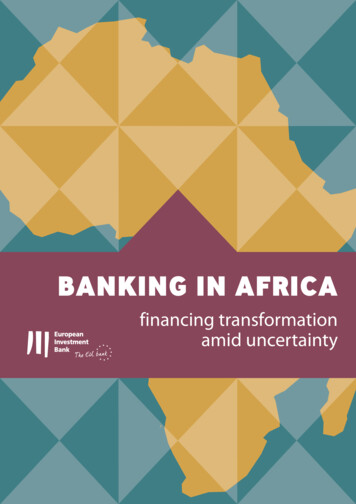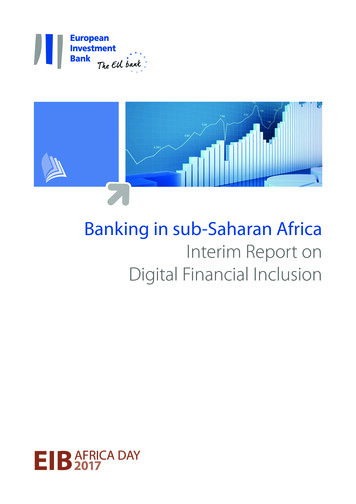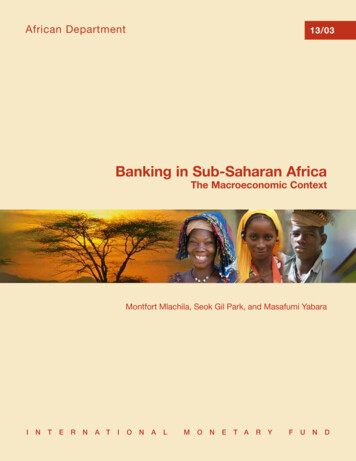
Transcription
African Department13/03Banking in Sub-Saharan AfricaThe Macroeconomic ContextMontfort Mlachila, Seok Gil Park, and Masafumi YabaraInterna tionalMonet ar yFund
African Department13/03Banking in Sub-Saharan AfricaThe Macroeconomic ContextMontfort Mlachila, Seok Gil Park, and Masafumi YabaraI n t e r n a t i o n a lM o n e t a r yF u n d
2013 International Monetary FundCataloging-in-Publication DataJoint Bank-Fund LibraryMlachila, Montfort.Banking in Sub-Saharan Africa : the macroeconomic context/Montfort Mlachila, Seok Gil Park and MasafumiYabara. – Washington, D.C. : International Monetary Fund, 2013.p. : ill. ; cm.Includes bibliographical references.ISBN: 978-1-48434-453-81. Banks and banking – Africa, Sub-Saharan. 2. Economic development –Africa, Sub-Saharan. 3. Financial institutions – Africa, Sub-Saharan.4. Africa, Sub-Saharan—Economic conditions. 5. Macroeconomics.I. Park, Seok Gil. II. Yabara, Masafumi. III. International MonetaryFund.HG3881.5.M53 2013Disclaimer: The views expressed in this book are those of the authorsand should not be reported as or attributed to the International MonetaryFund, its Executive Board, or the governments of any of its membercountries.Please send orders to:International Monetary Fund, Publication ServicesP.O. Box 92780, Washington, DC 20090, U.S.A.Tel.: (202) 623-7430Fax: (202) 623-7201E-mail: publications@imf.orgInternet: pass-0FM-r01.indd ii9/5/2013 8:12:45 AM
ContentsExecutive SummaryvIntroductionvii1. Economic Growth in Sub-Saharan AfricaSub-Saharan Africa’s Long-Delayed Growth SpurtRecent Macroeconomic Developments and Near-Term OutlookLonger-Term Challenges: Diversification and Structural Transformation2. The Banking Systems of Sub-Saharan AfricaStylized FeaturesBanking Sector Developments during the Global Economic CrisisSSA Banking Systems: New Forces at WorkPolicy Challenges for Regulatory AuthoritiesReferences1149121216182223FiguresFigure 1. Real GDP Growth (4-year moving average)Figure 2. Sub-Saharan Africa: Headcount Poverty Index Usingthe 1.25 a Day Poverty LineFigure 3. Sub-Saharan Africa and Other World Regions:Real GDP Growth, 2007–13Figure 4. Sub-Saharan Africa: Food and Nonfood Inflation,January 2008–December 2012Figure 5. Sub-Saharan Africa: Overall Fiscal Balance, 2007–14Figure 6. Sub-Saharan Africa: Government Debt Ratios, 2002–12Figure 7. External Current Account Balance, 2004–14Figure 8. Financial Depth and Access to Financial ServicesFigure 9. Commercial Bank IndicatorsFigure 10. Sub-Saharan Africa: Systemic Banking Crises, 1980–2010Figure 11. Sub-Saharan Africa: Banking System Funding, June 2011Figure 12. Sub-Saharan Africa: Financial Stability IndicatorsFigure 13. Sub-Saharan Africa: Selected Pan-African BankingGroups, June 2011TablesTable 1. Sub-Saharan Africa: Macroeconomic M-r01.indd iii9/5/2013 8:12:45 AM
This page intentionally left blank
Executive SummaryThis paper1 reviews the macroeconomic performance of sub-SaharanAfrica (SSA) in the last decade and examines factors that have supportedthe region’s generally robust growth and challenges going forward. It alsoassesses the main features and performance of SSA banking systems,while drawing attention to new developments that are taking place in SSA’sfinancial sector. The main findings are as follows: SSA’s sustained strong growth since the mid-1990s represents a sharpbreak with previous years; contributory factors include improvedmacroeconomic policies, trade and regulatory reforms, favorablecommodity price trends and new resource discoveries, debt relief, andreduced levels of armed conflict in the region. Most SSA economies showed significant resilience during the globaleconomic crisis, with annual growth of regional GDP now runningat 5.4 percent per annum. Adverse new developments in the globaleconomy would slow the pace of SSA growth, but the impact, in mostcountries, should be modest rather than severe. Banking systems in most of SSA remain underdeveloped as comparedwith other developing regions, but gradual financial deepening is underway in most countries. Impediments to development include the smallsize of national markets, low income levels, and weak creditor rights andjudicial enforcement mechanisms. Recent developments, such as the expansion of mobile phone–basedbanking and the spread of pan-African banking groups, have thepotential to significantly change the landscape for banking in much ofSSA, but they also introduce new challenges for financial regulators.This paper was originally prepared for a roundtable event hosted by the Economics Department of theEuropean Investment Bank in Luxembourg on January 23, 2013, and the original version is available conomic-report-banking-africa.htm. The authors greatlyappreciate useful comments by Seán Nolan. The authors are also grateful for research assistance provided byEmily Forrest.1v6240-022-3pass-0FM-r01.indd v9/5/2013 8:12:45 AM
This page intentionally left blank
IntroductionMany countries in sub-Saharan Africa (SSA) have seen accelerated growthfor an extended period since the mid-1990s, making a clear break with theirlong stagnant growth during the previous two decades. That said, the regionfaces significant challenges over the medium to long term, including reducingpoverty, overcoming infrastructure bottlenecks, enhancing productivity andskill levels, and improving the business climate, among others. The bankingsector remains underdeveloped in SSA, thus reducing its contribution togrowth, although its limited integration with global financial markets helpedcountries weather adverse effects of the global financial crisis. It is imperativethat the banking sector plays a more active role in SSA, in order to achievesustainable growth led by the private sector.This paper, building on the recent literature on SSA, discusses the mainfeatures of the region’s growth and macroeconomic performance in recentyears and the outlook for the coming years; it then reviews the main featuresof SSA banking systems and how they were affected by the global economiccrisis, while flagging some factors that could influence financial sectordevelopments in SSA in the period ahead.vii6240-022-3pass-Intro-r01.indd vii9/5/2013 7:08:55 AM
This page intentionally left blank
CHAPTER1Economic Growth in Sub-Saharan AfricaSub-Saharan Africa’s Long-Delayed Growth SpurtFor the first time since the 1970s, a large number of countries in sub-SaharanAfrica (SSA) have been enjoying an extended period of strong economicgrowth.2 The pickup in growth began in the mid-1990s and has beenmaintained in good part during the extended global slowdown since 2008(Figure 1). The acceleration in growth has been accompanied, and facilitated,by a sharp reduction in consumer price inflation: most SSA economies nowtypically record single-digit annual inflation, although inflation rates remainvulnerable to food and fuel price shocks.3The pace of growth recorded in SSA since the mid-1990s is not exceptionalby developing country standards, but it still represents a sharp break withthe experience of falling living standards and macroeconomic instability inSSA during the previous two decades—a period when the region fell behinddeveloping countries in other parts of the world. Key factors contributing tothis turnaround in economic fortunes include the following4: Improved macroeconomic policies, including the strengthening of fiscalpositions, the enhanced emphasis given to containing inflation, theliberalization of exchange controls and unification of exchange rates, andthe building of foreign reserves to help contain the impact of adverseexternal shocks. These shifts in domestic policy were facilitated byinternational debt relief initiatives, which freed up fiscal space and easedexternal payments pressures.The definition of SSA used here follows that employed in the IMF’s biannual publication, Regional EconomicOutlook: Sub-Saharan Africa, available at www.imf.org. Most of the data cited excludes South Sudan, now includedin SSA, due to lack of data availability.3 Twelve-month inflation over the course of 2012 is set to be in single digits in 36 of SSA’s 45 economies,exceeding 20 percent in only one case.4 For elaboration on these issues, see IMF (2008), chapter 2, and IMF (2012b), chapter 1.216240-022-3pass-001-r01.indd 19/5/2013 8:49:55 AM
BANKING IN SUB-SAHARAN AFRICA: THE MACROECONOMIC CONTEXTFigure 1. Real GDP Growth (4-year moving average)12WorldSub-Saharan Africa10Developing AsiaAdvanced 98979619950Source: IMF, World Economic Outlook database. Trade and regulatory reforms, with an associated scaling back of direct stateparticipation in economic activity. Trade liberalization and regulatory reformsincreased domestic competition and reduced inefficiencies, as did theprivatization or commercialization of poorly managed state enterprises.But there is still much more that can be done to improve the businessclimate in many countries, and intraregional trade, though rising, remainsat modest levels. Increased capital spending, in both natural resource and other sectors, helpedby an increase in domestic savings rates. The infrastructure deficit stillremains very wide in many countries, acting as an important bottleneckto growth—but also providing opportunities for boosting output andproductivity levels through appropriately selected and effectively executedinvestment projects. Improvements in institutional capacity. Although most indicators of goodgovernance still show SSA lagging behind the rest of the world, theregion is making up ground in some aspects, including in regard to publicvoice and accountability. And stronger governance has been an importantfeature of fast-growing SSA economies that are not resource-rich. Favorable commodity price trends and new resource discoveries, which haveprovided an important stimulus to growth in many mineral-richeconomies. But growth has also been strong in numerous non–resource-rich countries whose terms of trade were adversely affectedby surging oil prices; examples include Burkina Faso, Ethiopia,Mozambique, Rwanda, and Uganda.26240-022-3pass-001-r01.indd 29/5/2013 8:49:56 AM
Economic Growth in Sub-Saharan Africa Reduced armed conflict and social turmoil. The incidence of armed conflictand civil turmoil has declined significantly over the past two decades,although security tensions still pose threats to growth in several countries. Improved financial sector performance. Although financial systems in mostcountries remain poorly developed relative to other regions, therehas been significant financial deepening in most countries over time.Moreover, the incidence of systemic banking crises in SSA has come toa near halt since the mid-1990s (see Chapter 2, “The Banking Systems ofSub-Saharan Africa”).In discussing trends for SSA as a whole, it is important to keep in mind thestriking diversity of the region, whose 45 countries vary markedly in terms ofpopulation size, income levels, resource endowments, access to internationaltransportation corridors, and the extent of sociopolitical stability.5 These diverseconditions have had significant effects on the pace of growth over the past twodecades—although, in some cases (e.g., landlocked versus coastal, resource-richversus non–resource-rich), the impact on growth has been less marked than onemight have expected. Specific points worth noting include the following: South Africa, the region’s largest and most developed economy, hasgrown at a significantly slower pace than the region as a whole, reflectingboth post-apartheid challenges and the reduced opportunity for “catchup” given already high productivity levels. Countries affected by internal conflict and enfeebled governments(“fragile states”) have done much less well than others in the region,typically experiencing stagnant or falling living standards (e.g., Côted’Ivoire, Democratic Republic of the Congo).6 Leaving aside oil exporters, low-income countries not classified as fragilehave experienced above-average growth by regional standards, averagingannual growth of 5.5 percent during 1995–2010, as compared with 3.4percent for other non-oil SSA economies and 1.8 percent for fragile states.Finally, although output growth across most of the region has been strongsince the mid-1990s, this growth spurt, in many cases, took place from a verylow base in terms of income and productivity levels, in part reflecting dismaleconomic performance during the previous two decades. Per capita income inmost SSA countries remains very low by international standards, and povertyheadcounts, although falling, are higher than in other developing regions ofNote that South Africa and Nigeria together account for about one-half of SSA GDP, thus playing a veryimportant role in influencing the evolution of the macroeconomic aggregates for the region as a whole.6 For a listing of fragile states, based on the World Bank’s IDA Resource Allocation Index, see IMF (2012c).536240-022-3pass-001-r01.indd 39/5/2013 8:49:56 AM
BANKING IN SUB-SAHARAN AFRICA: THE MACROECONOMIC CONTEXTFigure 2. Sub-Saharan Africa: Headcount Poverty Index Usingthe 1.25 a Day Poverty LineSub-Saharan Africa1990South Asia20102015 MDG targetLa n Americaand the CaribbeanEast Asia and Pacific0102030405060Source: World Bank, World Development Indicators.Note: MDG the United Nation’s Millennium Development Goals.the world (Figure 2).7 Much has been achieved in recent years, but stronggrowth will be needed for many years to come if poverty levels are to bereduced decisively in SSA.Recent Macroeconomic Developments and Near-Term OutlookThe onset of the global economic crisis in late-2008 saw a marked slowdownin the pace of global economic growth, most notably in the advancedeconomies. Global growth, running at about 5 percent per annum in theprecrisis period, fell to below 3 percent per annum during 2009–12, with anabsolute decline in output recorded in 2009. The near-term outlook is for amarginal pickup in activity in 2013, with growth on the order of 3.3 percentfor the global economy and some 1.2 percent in the advanced economies,with significant downside risks still remaining (Table 1).Most SSA economies (Figure 3) have shown significant resilience in the faceof these adverse external developments. Growth slowed noticeably in theregion in 2009, but there were marked differences between the experienceof many middle-income countries (notably South Africa), where closerintegration into international markets resulted in a sharp adverse shock toGDP, and non-oil, low-income countries, where the slowdown was quitemodest. Oil exporters were hit by the sharp drop in world prices in 2009,although growth was sustained in Nigeria (despite the adverse effects of the2012 floods) by the use of sizable oil revenue savings accumulated in previousyears to support public spending levels and non-oil activity. Since 2009,growth has been strong—albeit below precrisis levels—across most of the7Twenty-five of the thirty-four countries now classified as “low income” by the World Bank are in SSA.46240-022-3pass-001-r01.indd 49/5/2013 8:49:56 AM
Economic Growth in Sub-Saharan AfricaTable 1. Sub-Saharan Africa: Macroeconomic IndicatorsReal GDP growthSub-Saharan Africa (Total)Of which:Oil-exporting countriesMiddle-income countries1Of which: South AfricaLow-income countries1Fragile statesMemo item: World GDP growthInflation, end-of-periodFiscal balanceOf which: Excluding oil exportersCurrent account balanceOf which: Excluding oil exportersReserves 8 0.6 1.55.53.3 0.68.61.9 0.70.6 5.1 5.6 4.8 3.1 5.34.85.120102011201220132014(Percentage .36.66.54.05.8 2.7 4.1 3.5 7.8 2.8 3.2 4.1 47.05.24.03.27.210.17.9(Percent of GDP) 3.9 1.3 1.7 4.6 3.7 4.5 1.3 1.7 2.8 4.7 5.0 7.9(Months of imports)4.24.54.7Source: IMF, World Economic Indicatior database.Note: Excludes South Sudan.1Excluding fragile states.Figure 3. Sub-Saharan Africa and Other World Regions: Real GDP Growth, 2007–13WorldNon-SSA developing countriesSSA low-income countries8127Average, SSAOil exportersMiddle-income countriesLow-income countriesFragile states1085Percent changePercent 08–22007–2Source: IMF, World Economic Outlook database.Note: SSA sub-Saharan Africa.56240-022-3pass-001-r01.indd 59/5/2013 8:49:57 AM
BANKING IN SUB-SAHARAN AFRICA: THE MACROECONOMIC CONTEXTregion, with the exceptions including South Africa, where sluggish demandgrowth in Europe has contributed to a muted recovery, and a number ofpolitically fragile states.What explains the resilience of economic activity in SSA during the crisis,a marked contrast with the region’s experience in previous global downturns?Contributory factors include the following: The buildup of solid fiscal positions in the precrisis period allowed manycountries to support domestic demand by maintaining or increasingpublic spending levels; declines in budget revenues were instead reflectedin higher fiscal deficits. Key prices for SSA commodity exports, including oil, have remainedat relatively high levels since 2010, helped by continued strong demandfrom Asia.8 Supply-side factors have been generally favorable—natural resourcediscoveries, continued agricultural output growth, dynamism in selectedservice activities—although adverse climate shocks have seen sharpfluctuations in food production in the Sahel and eastern Africa. SSA financial systems were relatively insulated from the global financialturmoil (see Chapter 2, “The Banking Systems of Sub-Saharan Africa”),ensuring that few countries were significantly affected by disruptions tocredit availability.Inflation in SSA has shown significant volatility since 2008, mainly due tomovements in world food and fuel price levels, although domestic food supplyconditions played an important contributory role in some subregions (Figure4). The volatility has been most marked in low-income countries, where foodand fuel products account for a larger share of the consumer price index andwhere central banks, in many cases, have more limited capacity to influencethe pace of inflation. Of late, easing price pressures in global commoditymarkets, coupled with the impact of monetary tightening (notably in EastAfrica) and recovery from drought in the Sahel and the Horn of Africa,have contributed to a significant slowing of inflation, which declined to a(weighted) average rate of below 8 percent as of end-2012, with some furthereasing expected in 2013.Fiscal positions have weakened across most of SSA since 2008, reflectingpolicy decisions to support economic activity by maintaining public spendinglevels notwithstanding revenue erosion and, in several cases, to take advantageFor discussion of the reorientation of SSA trade and investment toward nontraditional partners, most notablyChina, see IMF (2011), chapter 3.866240-022-3pass-001-r01.indd 69/5/2013 8:49:57 AM
Economic Growth in Sub-Saharan AfricaFigure 4. Sub-Saharan Africa: Food and Nonfood Inflation,January 2008–December 201225Twelve-month percent changeTotal infla onFood infla on20Nonfood infla on15105Jan20Ap 08r-0Ju 8l-0Oc 8t-0Ja 8nAp 09r-0Ju 9l-0Oc 9t-0Ja 9nAp 10r-1Ju 0l-1Oc 0t-1Ja 0nAp 11r-1Ju 1l-1Oc 1t-1Ja 1nAp 12r-1Ju 2l-1Oc 2t-120Sources: IMF, African Department database; and IMF, International FinancialStatistics.Figure 5. Sub-Saharan Africa: Overall Fiscal Balance,2007–148Sub-Saharan AfricaOil exporters6Middle-income countriesLow-income and fragile countriesPercent of .Source: IMF, World Economic Outlook database.Note: Excludes South Sudan.of post–debt relief borrowing space to finance new public investmentprojects (Figure 5). Oil exporters have seen a return to fiscal surpluses since2010, helped by stronger world prices, but significant fiscal deficits remain thenorm in the other country groupings. Sluggish economic recovery continuesto constrain the scope for fiscal consolidation in South Africa, whereas76240-022-3pass-001-r01.indd 79/5/2013 8:49:57 AM
BANKING IN SUB-SAHARAN AFRICA: THE MACROECONOMIC CONTEXTpolitical factors (e.g., resistance to scaling back energy subsidies) and publicinvestment needs are constraining fiscal tightening in many other countries.The impact of larger fiscal deficits on public debt burdens across the regionas a whole has been limited (Figure 6), although experience at the countrylevel has been varied. Debt burdens in several middle-income countries haverisen significantly since 2008, given the conjunction of larger deficits andslower growth. South Africa’s public debt rose from 28 percent of GDP atend-2008 to 42 percent of GDP by end-2012. For low-income countries, debtburdens have fallen sharply in several cases (such as Côte d’Ivoire, DemocraticRepublic of the Congo, and Liberia) with the completion of multilateral debtrelief processes, but have drifted upward since 2008 in a number of post–debtrelief cases (such as Tanzania and Uganda).The weak external environment since 2008 has adversely affected exportsfrom the region, contributing to a weakening of external current accountpositions in many countries, although rising investment levels and associatedimports of capital goods have also made an important contribution (Figure 7).Service exports and remittances have generally remained quite strong acrossthe region. Helped by ongoing capital inflows, foreign reserve levels have risenin absolute terms in most SSA countries, but import coverage ratios (foreignreserves divided by monthly imports of goods and services) have typicallyfallen, given fast-growing import levels.Looking ahead to 2013 and 2014, a moderate acceleration of growth at about5.5 percent is expected for the whole SSA, with middle-income countriesFigure 6. Sub-Saharan Africa: Government Debt Ratios,2000–12180160Second and third quar lesMedianPercent of ource: IMF, World Economic Outlook database.86240-022-3pass-001-r01.indd 89/5/2013 8:49:57 AM
Economic Growth in Sub-Saharan AfricaFigure 7. External Current Account Balance, 2004–1415Sub-Saharan AfricaOil exporters10Middle-income countriesPercent of GDPLow-income and fragile .14Proj.Source: IMF, World Economic Outlook database.continuing to expand at a slower pace than other country groupings. Themain risks to the outlook come from the external environment, althoughdomestic political and security risks pose specific threats in several countries(as highlighted by developments in Mali and, more recently, the CentralAfrican Republic). Further weakening of the global economy wouldundoubtedly have an adverse effect on prospects for SSA—but the experiencesince 2008 suggests that, absent some major destabilizing shock, the impacton regional growth should be moderate rather than dramatic.Longer-Term Challenges: Diversification and Structural TransformationThe strong growth recorded in much of SSA since the mid-1990s has beenbased in part on the gathering of “low-hanging fruit”: reversing the policyerrors of the past, containing or recovering from internal conflict, takingadvantage of expanded aid flows, and debt relief. But progress in achievingsignificant structural transformation and diversification of production andexports has been modest.9 Productivity growth in agriculture has been high inrelatively few countries. Manufacturing sectors—the driver of growth in mostversions of the “Asian miracle”—have shown dynamism in very few cases.Service sector growth has seen the expansion of high productivity sectors(such as telecommunications) but also of low-productivity informal sectoractivities.9For further discussion of the issue of structural transformation, see IMF (2012c), chapter 3.96240-022-3pass-001-r01.indd 99/5/2013 8:49:57 AM
BANKING IN SUB-SAHARAN AFRICA: THE MACROECONOMIC CONTEXTDemographic trends point to a surge in the working-age population in theregion in the coming years—a stimulus for growth, in the form of expandedlabor supply, but also a challenge to policymakers to create the appropriateenvironment for rapid job creation. What are the prospects for meeting thischallenge?On the positive side: The price outlook for SSA’s main commodity exports is broadlyfavorable, given expectations of continued strong growth in China andother large emerging market economies—although “rebalancing” ofdemand within these countries could adversely affect commodities, suchas copper, that are closely linked to construction. Exports of nonrenewable natural resources appear set to rise in manycountries, given new discoveries in both established producers (such asAngola) and new producers (such as Mozambique and Tanzania). Crop yields in most SSA countries are very low by internationalstandards, providing opportunities to boost agricultural productivitythrough effective water management, expanded use of fertilizers, andimproved extension services. Rising wage levels in China and other established producers of laborintensive manufactures in the coming years are likely to push largenumbers of jobs offshore, including to competitive low-wage economiesin SSA.But taking full advantage of these opportunities and achieving broad-basedinclusive growth will require that governments deliver in several key areas10: Infrastructure deficits, notably in electricity provision and transportation,will need to be overcome. Financing the required investments willneed a mix of fiscal measures to free up budgetary resources andjudicious external borrowing, preferably on concessional terms, whereasgovernment capacity in such areas as project appraisal and managementwill need strengthening if investments are to deliver the desired results. Skill/productivity levels will need to be improved, including throughbetter education and basic health services; this in turn will require bothadditional budgetary resources and improvements in the quality ofservice delivery.For an interesting recent discussion of these challenges, placing emphasis on the importance of policyreforms to improve public service delivery, see Devarajan and Fengler (2012), echoed in World Bank (2012).10106240-022-3pass-001-r01.indd 109/5/2013 8:49:57 AM
Economic Growth in Sub-Saharan Africa Promoting agricultural development, key to ensuring growth is inclusive,will require policy initiatives to improve water management and accessto fertilizers, new seeds, and knowledge—pointing to the need to buildcapacity to deliver such services. Private sector expansion at a pace needed to absorb the labor force inhigher productivity jobs will require significant improvements in thebusiness climate, including further deregulation and active measuresto strengthen judicial systems, professionalize tax administration,and appropriately target measures to enhance access to finance in asustainable manner for small to midsized enterprises.Of course, maintaining the track record of sounder macroeconomicmanagement, greater reliance on markets over administrative controls, andexpanded integration with the international economy will remain essentialif the current pace of growth is to be sustained. Finally, addressing thespecial challenges faced in fragile states, where development partners have animportant supporting role to play, is an imperative if SSA’s growth is to betruly inclusive, in the sense of delivering growth in living standards across theregion as a whole.116240-022-3pass-001-r01.indd 119/5/2013 8:49:57 AM
CHAPTER2The Banking Systems of Sub-Saharan AfricaStylized FeaturesFinancial sectors are generally underdeveloped in sub-Saharan Africa (SSA),with banking systems accounting for the preponderance of financial sectorassets and activities.11 Helped by reform efforts (Kasekende, 2010), the depthand coverage of financial systems—as measured by the ratios of broad money(M2) and private sector credit to GDP—have been gradually increasing overthe past decade, albeit from a low base (Figure 8, Panels A and B). But the scaleof financial intermediation in the region remains significantly lower than inother developing regions of the world, whereas access to financial services isalso relatively low, reflecting a combination of low income levels, small absolutesize, and infrastructure weaknesses (Figure 8, Panel C). Confirming theseobservations, a recent World Bank study notes that SSA typically scores lowestamong the world’s developing subregions on various dimensions of financialdevelopment, such as depth and efficiency of financial institutions (Čihák et al.,2012).Most banking systems in SSA are small in absolute and relative size.12 Theyare characterized by low loan-to-deposit ratios (Figure 9, Panel A) and, as acorollary, large shares of assets held in the form of government securitiesand liquid assets. Lending is mainly short-term in nature, with about 60percent of loans having a maturity of less than one year. Market structuresare typically oligopolistic, as indicated by the high share of total assetsaccounted for by the three largest banks (Panel B), which tends to constrainthe intensity of competition. SSA banks are typically high-cost operationsThe discussion here focuses primarily on banking and financial systems in SSA’s low-income countries. Thelevel of financial sector development is significantly more advanced in a number of middle-income countries inthe region—including South Africa, its smaller partner countries in the Southern African Customs Union, andMauritius.12 For a fuller discussion of SSA banking systems, see IMF (2006), chapter 4, and Beck et al. (2011), chapter 2.11126240-022-3pass-002-r01.indd 1
Figure 2. Sub-Saharan Africa: Headcount Poverty Index Using the 1.25 a Day Poverty Line 4 Figure 3. Sub-Saharan Africa and Other W orld Regions: Real GDP Growth, 2007–13 5 Figure 4. Sub-Saharan Africa: Food and Nonfood Infl ation, January 2008–December 2012 7 Figure 5. Sub-Saharan
